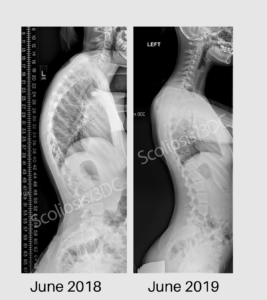Kyphosis is a condition of the sagittal plane of the spine (looking at the spine from the side). Kyphosis patients will appear to have a rounded back in the thoracic area. Normal Cobb angle measurements in the sagittal plane typically range from 20-45º in the thoracic spine. Any thoracic curve above 45º is considered to be a kyphosis, also known as ‘hyperkyphosis.’

Kyphosis can present by itself or be accompanied with scoliosis. When this occurs, the condition is referred to as kyphoscoliosis. The incidence of kyphosis is far greater in men than in women. Some cases of kyphosis are postural. When this occurs, it can usually be improved when the patient consciously corrects their posture. This postural problem is usually due to weak spinal extensor muscles. In contrast, Scheuermann’s disease, the most severe form of kyphosis, is a structural kyphosis due to vertebral deformation.
Scheuermann’s is caused by anterior wedging of vertebrae, usually in the thoracic spine and less frequently in the thoracolumbar region. In the growing child, the anterior (front) part of the vertebrae doesn’t grow as much as the posterior (back) part of the vertebrae. As a result, the child with Scheuermann’s is vulnerable to increased progression, so it is important to counteract the asymmetric loading during periods of growth. Patients with Scheuermann’s often present with an accompanying lumbar hyperlordosis and cervical hyperlordosis with forward head posture. We find that many kyphosis patients also present with tight hamstring muscles.
With Scheuermann’s disease, the apex of the curve is quite rigid. Very stiff curves of 75º or more are likely to cause discomfort. In cases of severe Scheuermann’s, whether adolescent or adult, there can be increased pressure on the internal organs creating wear and tear. In these cases, surgical intervention may be required.
Scoliosis 3DC® Treatment Options for Kyphosis Patients

We offer non-surgical treatment options for kyphosis/kyphoscoliosis including customized Schroth method programs and kyphosis bracing. Patients with thoracolumbar/lumbar kyphosis (typically adults) may also benefit from Schroth method exercises or a custom-created brace. To learn more about your options, please click below.
The patient whose X-rays appear on the left has reduced her kyphosis from 68º to 43º while under our care.
Learn More About Kyphosis Treatment
